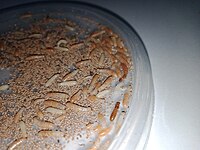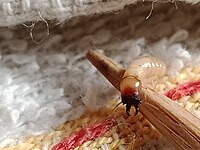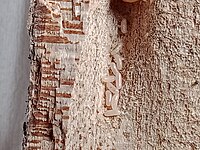Cryptotermes dudleyi
| West Indian drywood termite | |
|---|---|

| |
| Scientific classification | |
| Domain: | Eukaryota |
| Kingdom: | Animalia |
| Phylum: | Arthropoda |
| Class: | Insecta |
| Order: | Blattodea |
| Infraorder: | Isoptera |
| Family: | Kalotermitidae |
| Genus: | Cryptotermes |
| Species: | C. dudleyi
|
| Binomial name | |
| Cryptotermes dudleyi Banks, 1918
| |
| Synonyms | |
| |
The West Indian drywood termite[1] (Cryptotermes dudleyi) is a species of dry wood termite of the genus Cryptotermes. It is native to Java, Indonesia and exotic to Australia, Trinidad and Tobago and Sri Lanka. It is predominantly a house termite found in natural and man-made wooden structures. Thus, this is the most commonest and most devastating drywood pest termite found in the world.[2] It is a larger termite species, with 4.55–7.15 millimetres (3⁄16–9⁄32 in) length in soldiers.
Description[edit]
- Imago - General body color is tawny brown. Wings are faintly tinged with brown. Sub-triangular eyes are prominent and large. Antennae composed of 15-18 segments.
- Soldier - Head yellowish brown. Antennae are pale yellow-brown in color. Prominent genal horns.[3]
Castes[edit]
-
Primary Reproductives
-
Workers/Pseudergates
-
Soldier
-
Neotenic Reproductive
-
Eggs
References[edit]
- ^ "West Indian drywood termite". The State of Queensland (Department of Agriculture and Fisheries). Archived from the original on 15 February 2017. Retrieved 14 February 2017.
- ^ "An annotated checklist of termites (Isoptera) from Sri Lanka". National Science Foundation. Retrieved 14 February 2017.
- ^ "Cryptotermes dudleyiBanks(Isoptera: Kalotermitidae)". PaDIL. Retrieved 14 February 2017.





